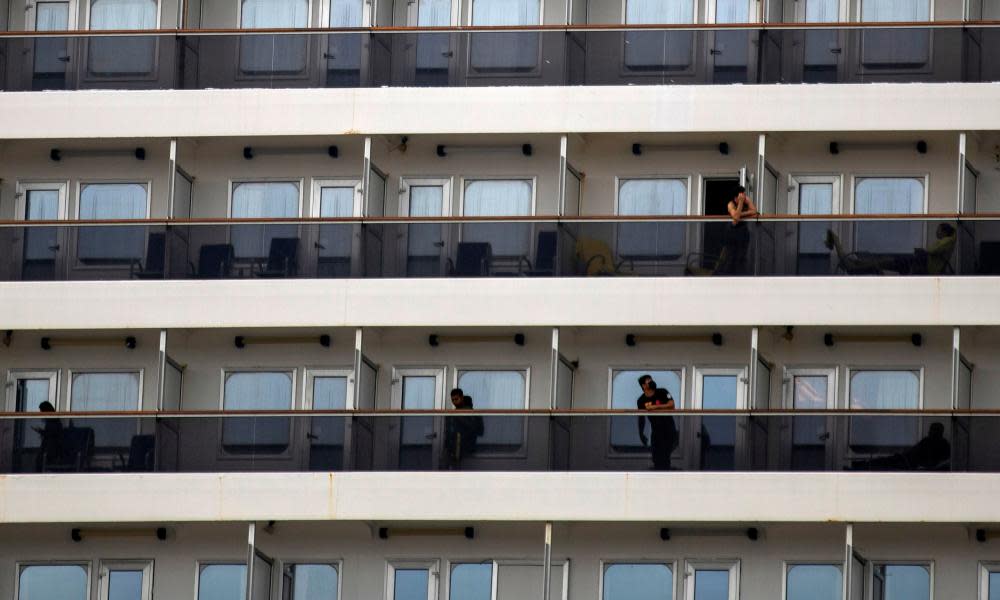Should passengers return to cruise ships after the pandemic? No

Since the coronavirus outbreak, cruise ships have transformed from (polarizing) sites of pleasure to floating dungeons where the extremely unlucky have been, or continue to be, confined. The Guardian recently reported that, as of last Friday, more than 6,300 people – crew and passengers alike – were still stranded on cruise ships.
Related: Revealed: 6,000 passengers on cruise ships despite coronavirus crisis
Those stuck aboard are understandably frightened and uncertain. The sick are unable to receive long-term care, and the threat of contagion is omnipresent. A wave of would-be vacationers who have returned to dry land are launching lawsuits against cruise companies; some have accused cruise operators of endangering passengers by covering up cases of coronavirus onboard. Indeed, cruise companies – despite claiming to have been blindsided by the speed and severity of the coronavirus outbreak – continued to launch voyages even after the World Health Organization (WHO) declared a pandemic.
Between cruise operators’ disastrous pandemic response and the economic effects of the pandemic, the future of the cruise industry is uncertain. Cruise operators are no doubt wondering when – or if - passengers will return. But the better question is: Should passengers return?
There are plenty of reasons for the answer to be no.
For many tourists, cruises are the ideal vacation – a chance to see the world with limited hassle and unlimited buffets. But, as Covid-19 has emphasized, in addition to convenience and luxury, cruises also provide a golden opportunity to get sick. Even in the absence of a global pandemic, cruise ships are ideal incubators of infectious diseases.
The Centers for Disease Control and Prevention (CDC) investigates about 13 outbreaks of gastrointestinal bugs like E coli and norovirus aboard cruise ships a year; influenza and chickenpox are also fairly common. Last May, measles broke out aboard a Scientology cruise. Yes, you can get sick anywhere, but according to Tara C Smith, professor of epidemiology at Kent State University, cruise ships genuinely amplify the risk of infection – in part because of the close quarters onboard, and in part because passengers are at the mercy of companies’ hygienic standards. In 2019, Carnival Cruises failed sanitation inspections for offenses including “brown water” discharge from showers in the medical center and unclean food service utensils. Moreover, when you fall ill on a cruise you are dependent on contractor physicians who charge high fees regular health insurance is unlikely to cover.
A passenger’s carbon footprint triples in size when taking a cruise
After investigating air quality on cruises, the Johns Hopkins University professor Ryan David Kennedy told CNN their onboard air pollution was “comparable to concentrations measured in polluted cities, including Beijing and Santiago”. Yet the health risks posed by cruise ship emissions do not only affect their passengers. As Forbes reports, a single cruise ship emits daily pollution equal to a million cars. A passenger’s carbon footprint triples in size when taking a cruise. The Royal College of Physicians estimates that the premature deaths of about 40,000 Britons every year are linked to air pollution, with the cruise and shipping industry being major contributors.
Then, there’s the fact that cruises expel enormous quantities of hideous discharge into the ocean. Cruises are notorious for covering up the fact that they illegally dump sewage, garbage and sulfurous fuel waste – sometimes even in the protected waters of national parks. Carnival Corp’s environmental violations date back to 1993 and they still haven’t cleaned up their act.
Then again, why would they? Even massive fines – such as the $40m US Carnival was charged in 2016 for illegally dumping oily water off the coast of England and trying to cover up the crime – hardly matter when some cruise companies earn revenues of almost $19bn annually, essentially tax-free. Cruise companies are able to exploit a loophole to avoid most US taxes and labor regulations; three major companies make up 70% of the global cruise market, all of which are incorporated in countries with tax and labor laws very different from those of the US.
Yes, many people who work on cruises are currently losing their jobs, and that is rightly sad. But bear in mind that the cruise industry’s economic model is built around hiring people from poor countries whose economic prospects are so bad they are willing to endure exploitation and mistreatment. Despite the industry’s massive profits, cruises pay employees as little as $600 a month.
Additionally, cruises further the misguided notion that vacationers should be entitled to travel anywhere, no matter how culturally and ecologically sensitive. Case in point: as sea ice dwindles, the Arctic has emerged as a chic destination, allowing cruise passengers to observe the effects of climate change while actively contributing to it.
It’s comforting to believe that our vacations benefit local communities – but that’s not always true, especially in the case of cruise tourism. Residents of Nunavut, Canada, have expressed concerns that cruise ships disrupt wildlife and threaten their culture. Investigations have also found that the sunny economic impact figures provided by the cruise industry may overstate the revenue their business actually brings to local communities.
When cruise lines are able to sail again, they will do their best to lure customers back with cheaper prices. Hopefully, the debacle of the cruise industry’s botched pandemic response has shown consumers what industry watchdogs have known for decades: the cruise industry is an ethical disaster that shirks accountability at every turn. It is not worth keeping afloat.
Adrienne Matei is a journalist who writes about technology and culture

